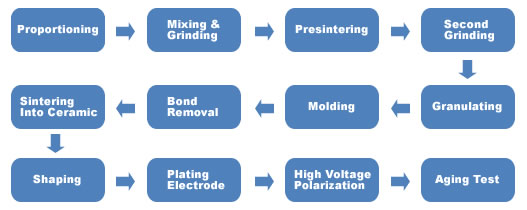|
|
|
|
|
|
Manufacturing Process Of PZT Ceramic |
|
|
16 Mar, 2015 |
Piezo Ceramic |
|
|
|
Overview of PZT ceramic
PZT ceramic, also known as material of lead zirconate titanate, is the kind of widely used piezo ceramic material. It is composed of the two chemical elements, lead and zirconium , which combined with the chemical compound titanate. PZT ceramic is made on condition of very high temperature, compare to the other piezo ceramic material, it has greater sensitivity and higher operating temperature.
PZT ceramic has a very important ability of piezoelectric effect. Under certain conditions, if a piezoelectric material is pressured to be deformed, an electric charge is generated in what is called the piezoelectric effect. The opposite situation is that electrical fields can deform PZT ceramic, this phenomenon is called the inverse piezoelectric effect.
Today PZT ceramic is commonly applied in many electronic fields. They are recognized as the most popular choice due to their great sensitivity, good temperature resistance and lower cost raw. Besides, they can be easily adjusted to meet the particular needs.
How to manufacturing PZT ceramic
Figure 1:

Figure 1 shows that the process of manufacturing PZT ceramics go through the 12 stages:
1) Proportioning: According to the formula ratio, weighing various of raw materials and don't forget to put the small amount additives inside.
2) Mixing & Grinding: The aim is to uniform the raw material and grind fine, generally through the way of dry grinding and wet grinding.
3) Presintering: Solid phase reaction at high temperature, to form the PZT ceramic powers, this step is significant for the final performance of products.
4) Second grinding: Grinding again, further improve its uniformity of performance.
5) Granulating: Translating the PZT ceramic powers into particles with high density and good fluidity, it's necessary to add binders in the process.
6) Molding: Pressuring the particles to form semifinished products with prefabricated dimension.
7) Bond removal:
Removing the bond which was added when granulating process.
8) Sintering into ceramic: Sintering the semifinished products into PZT ceramic at high tempature.
9) Shaping:
By grinding, get the finished products with certain shape and dimension that we need.
10) Plating electrode: Coating the metal electrode on surface, the general method contains silver layer sintering, chemical deposition and vacuum coating.
11) High voltage polarization: The inner domain of ceramics can orient in certain direction, so that the PZT ceramics can have piezoelectric property.
12) Aging test: Detecting each parameter when the materials are stable, then observe the PZT ceramics whether to achieve our expected performance.
|
|
|
« Back |
|
↑ Top |
|
|
|
|
 Downloads
Downloads Sitemap
Sitemap Downloads
Downloads Sitemap
Sitemap